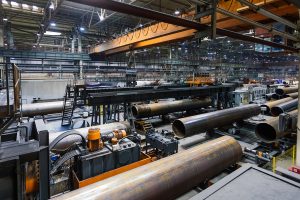The direction of steel depends on the demand side
Steel, a versatile and essential material, plays a pivotal role in various industries worldwide. From construction and automotive to manufacturing and infrastructure development, steel is the backbone that supports progress and innovation. However, the steel industry’s direction is not solely determined by its own supply and production capabilities but is heavily influenced by the demand side of the equation.
Demand for welded steel pipe fluctuates in response to economic conditions, global trends, and consumer preferences. During periods of economic growth, the demand for steel surges as construction projects flourish, automobile sales rise, and industrial production expands. Conversely, during economic downturns, the demand for steel declines as construction slows down, manufacturing contracts, and consumer spending diminishes.
The construction industry is one of the major drivers of steel demand. When construction activities are booming, steel consumption skyrockets due to the need for structural frameworks, reinforcement bars, and other construction materials. Rapid urbanization, population growth, and infrastructure development projects further propel the demand for steel. On the other hand, a slowdown in construction activities can create a slump in square tube demand, impacting the entire industry.
Another significant factor influencing steel demand is the automotive sector. As the automotive industry thrives, the need for round steel pipe for vehicle production increases. Steel’s strength, durability, and cost-effectiveness make it an ideal choice for automobile manufacturing. However, with the rise of electric vehicles and the growing demand for lightweight materials, the steel industry faces challenges in adapting to changing trends and demands. The industry must innovate and develop high-strength steels and explore alternative materials to remain competitive in the evolving automotive landscape.

Global trade and geopolitical factors also shape steel demand. Tariffs, trade agreements, and economic policies implemented by governments can have a profound impact on steel trade and consumption. Protectionist measures or trade disputes can disrupt the flow of steel across borders, leading to fluctuations in demand and affecting steel producers and consumers alike.
Moreover, consumer preferences and societal shifts influence steel demand indirectly. Environmental concerns, sustainability efforts, and the increasing focus on green technologies have led to a rise in demand for eco-friendly materials. Steel pipe manufacturers are responding by developing greener production methods, recycling initiatives, and low-carbon steel options to meet changing consumer expectations and regulatory requirements.
In conclusion, the direction of the steel industry is intricately tied to the demand side. Economic conditions, construction activities, automotive trends, global trade dynamics, and consumer preferences all play a significant role in shaping steel demand. To thrive in a rapidly changing world, the steel industry must adapt, innovate, and align its production capabilities with evolving market demands. By understanding and responding effectively to the demand side, the steel industry will continue to be a vital force driving progress and development across various sectors.
Tel: +86 18202256900 Email: steel@fwssteel.com










